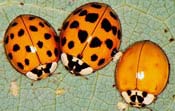 As the weather begins to turn from warm and muggy to cool fall temperatures, many New Jersey residents are shocked by the amount of ladybugs that are swarming around their homes and area businesses. The tiny oblong speckled beetles are not considered to be a bad type of insect like a cockroach or a bed bug though. They instead are categorized with other “good” bugs like butterflies and praying mantis.
As the weather begins to turn from warm and muggy to cool fall temperatures, many New Jersey residents are shocked by the amount of ladybugs that are swarming around their homes and area businesses. The tiny oblong speckled beetles are not considered to be a bad type of insect like a cockroach or a bed bug though. They instead are categorized with other “good” bugs like butterflies and praying mantis.
Ladybugs are also known as ladybird beetles and lady beetles. Ladybugs are actually considered to be a beneficial insect, especially to farmers. They have a ferocious appetite for several plant eating pests, especially aphids and other sap feeders. A single ladybug will eat approximately 5,000 aphids in its lifetime. Ladybugs don’t have many natural predators, presumably because their brightly colored exterior is a sign to would be eaters that they taste bad. Additionally, lady bugs also secrete a fluid from the joints in their legs that tastes foul to keep predators away.
Many ladybug species have been brought to the United States as a means of natural agricultural pest control. You can find ladybugs in a variety of colors such as pink, red, orange, yellow, and black. They are usually sporting their trademark spots on their back, which also helps deter predators away. At this time of year, many New Jersey residents confuse a ladybug with a nymph stink bug because of their similar appearance.
During the summertime, female ladybugs will lay their eggs in clusters in an area that is a good feeding source for their larvae. Once the ladybug larvae hatch, they too become immediate predators to aphids, mealy bugs, scales, insect eggs, small larvae, etc. A ladybug can live up to three years in the wild. Some species of ladybugs even eat pollen.